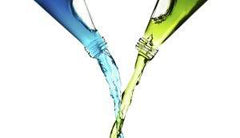How to Read Out the GPM of a Centrifugal Pump
Ask any HVAC test and balance technician in the hydronic system world to convert PSI to feet of water (or feet of head), and a multiplier of 2.31 is the immediate response. It is a simple conversion we learn early in our careers.
However, there are times when the multiplier for the conversion of PSI to feet of head (PSI to ft head) changes. Since specific gravity is normally close to one for water but is not so in glycol systems, pump differential pressure gauge readings from a hydronic glycol system require an adjusted multiplier to account for the change in specific gravity.
Failing to adjust the multiplier for glycol fluid may result in an assumed flow rate that doesn’t match the design, and when temperatures become really hot or cold, you may not be able to meet the occupants’ temperature requirements.
In this article, we will explore an example to illustrate the importance of adjusting the multiplier based on type of heat transfer fluid.

Formula to Calculate Feet of Head for Water System
Feet of Head (Ft of Water) = (PSI X 2.31 Multiplier) / Specific Gravity
Formula to Calculate Feet of Head for Glycol System
Feet of Head (Ft of Glycol) = (PSI X Multiplier from Table Below)
Table of Multipliers for Glycol Systems
| Propylene Glycol (DOWFROST or DOWFROST HD) |
| Concentration (% Glycol) |
(M) 35°F to 120°F |
(M) 121°F to 190°F |
| Water Only |
2.31 |
2.36 |
| 20% |
2.25 |
2.31 |
| 25% |
2.24 |
2.30 |
| 30% |
2.23 |
2.29 |
| 35% |
2.21 |
2.27 |
| 40% |
2.20 |
2.27 |
| 45% |
2.19 |
2.26 |
| 50% |
2.18 |
2.25 |
| Ethylene Glycol (DOWTHERM SR-1) |
| Concentration (% Glycol) |
(M) 35°F to 120°F |
(M) 121°F to 190°F |
| Water Only |
2.31 |
2.36 |
| 20% |
2.24 |
2.29 |
| 25% |
2.23 |
2.28 |
| 30% |
2.21 |
2.26 |
| 35% |
2.20 |
2.25 |
| 40% |
2.18 |
2.23 |
| 45% |
2.17 |
2.22 |
| 50% |
2.15 |
2.21 |
| a) Chart accuracy or rounding is ± 0.02 |
| b) Chart is based on the % by volume of DOWFROST mixed with water |
| c) ®™Trademark of The Dow Chemical Company ("Dow") or an affiliated company of Dow |
Does it Make a Difference in the Test and Balance Report?
In this example, we have a design condition of 1000 gallons per minute (GPM) at 90 feet. The heat transfer fluid is 50% Dowfrost HD (propylene glycol) at 40°F. The glycol concentration is known because the system fluids were purchased premixed with deionized water (DI water) from Go Glycol Pros.
If concentration is unknown, we recommend you use a refractometer to measure current glycol concentration.
Assume the pump differential pressure was 40 PSI.
40 PSI x 2.31 multiplier = 92.4 ft of head
This would indicate we are flowing 950 GPM or 5% below the design flow rate. If the test and balance technician uses the correct multiplier from the glycol table above, the multiplier would be 2.18.
The revised calculation is:
40 PSI X 2.18 multiplier = 87.2 ft of head
With the proper correction, the flow rate indicated is now 1050 GPM.

This simple example shows the balance report would be off by 10%. The report would indicate a lack of flow rather than the 5% additional flow that will occur.
Therefore, without the proper correction or adjustment to the multiplier for pumps with glycol heat transfer fluid, you may end up over pumping and wasting energy, or failing to meet the heating or cooling requirements due to under pumping.









